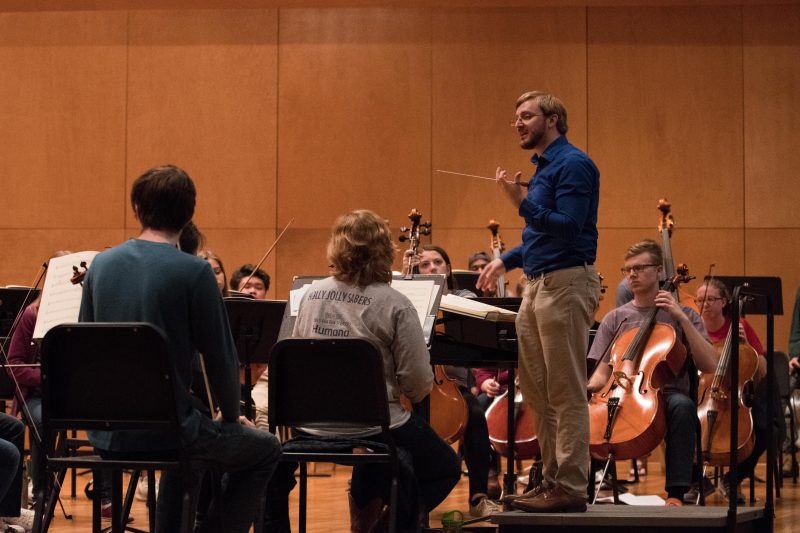“Maybe I shouldn’t have worn a sweater today,” said Joseph Kneer, conductor of the Trinity Symphony Orchestra. He lifted his baton and began another run of the fast and regal “Awake the Harp” movement. Despite the orchestra’s resonating, clear and bold sound, Kneer halted the piece midway through to correct an error. He uttered a profanity, removed his sweater from over his shirt and tossed it to the floor below.
In response to the unexpected performance, Gary Seighman, director of the Trinity choirs, let loose a wolf-like howl from the otherwise empty audience seating. Kneer delivered another cue and the orchestra once again roared to life, performing the piece with enough energy to light up the recital hall.
This strange, almost silly scene captures not only the efforts put forth by the Trinity Symphony Orchestra but also the excitement of Franz Joseph Haydn’s “Die Schöpfung” oratorio, better known in English as “The Creation.” This oratorio, which premiered in 1799, is a loose adaptation of the Book of Genesis, with additional influences from biblical psalms and even John Milton’s famous poem “Paradise Lost.”
“This work has been something we’ve had on our radar for a number of years. It was just a matter of finding the right year when we thought that the choir would be able to tackle it,” Seighman said.
This ambitious project, the Choral Union concert, was first teased in 2017’s spring concert when the Trinity Symphony Orchestra and the Choral Union performed the oratorio’s finale with featured performances from then-seniors Mariana Lopez-Levi and Matthew Reynolds, the two winners of that year’s Rosalind Phillips Vocal Competition. The orchestra and choir then performed the aforementioned “Awake the Harp” movement at this past year’s Christmas Concert under Seighman’s direction.
Although the concert would not take place for another six months, Kneer and the orchestra began work on “The Creation” almost as soon as rehearsals started in late August, dedicating short portions of each rehearsal to learning the piece.
Of course, a work of such a grand subject is not without its challenges. Both the orchestra and choir need to work around various issues regarding their numbers: The orchestra not always having enough musicians and the choir having such a large number of singers.
“No matter how well the people up front play and prepare, it’s tough to play with only two or three people around you playing the same part,” Kneer said.
Seighman discussed his perspective from the other end of the spectrum.
“Because we have so many singers, one aspect we focus on with the choir is preparing them to sing with the orchestra. It’s a very different kind of beast than singing with a piano or a cappella,” Seighman said.
“Performing this extended work is a large undertaking, one that most schools our size would not attempt. It requires a lot of stamina, an understanding of 18th century musical style and quite simply, it’s a heck of a lot notes to learn,” Seighman said. “Because it’s such a large, multi-movement work, we’re trying to get a sense of the whole piece so when we put it together it’s not so fragmented. We often work through a lot of transitions between movements so that the singers have a sense of the whole piece and what the text is about.”
Kneer also noted the piece’s overall difficulty.
“It’s harder than most things that we’ve played and even longer by far. It’s an hour … 30 minutes at least,” Kneer said. “In Haydn, there’s so much going on all the time. He fills up all the space with something and it’s genius, but it’s also a lot.”
In spite of the numerous challenges the ensembles faced, both directors were very pleased with the progress they had made over the year.
“The ‘Sunrise’ was really beautiful. It takes a lot of work to play beautifully in classic-era style. Even if you’re a specialty professional you have to do it all right. We’re not a professional group but I think we can do a lot of nice things,” Kneer said. “We set this year as kind of a goal to do it and I’m really happy with how it’s been going.”
The musicians themselves find the repertoire challenging as well.
“It’s an incredibly challenging repertoire and the orchestra is doing its best to keep up with it. But there are areas where we could definitely use improvement, especially in terms of style because the classical style is just incredibly idiosyncratic,” said Blue Mohr, junior cello player.
However, they are also quite pleased with the progress they have been making.
“It’s going pretty well. There’s obviously work to do but it’s progressing. It’s nice to hear it all come together,” said Lily Slemp, first-year and principal second violinist.
The Choral Union concert will take place at the Margarite B. Parker Chapel on Friday, Feb. 23.







